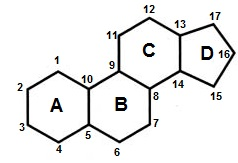Bio topic 2-3 - functional groups + macromolecules + protein structure
1/15
There's no tags or description
Looks like no tags are added yet.
Name | Mastery | Learn | Test | Matching | Spaced |
|---|
No study sessions yet.
16 Terms
Hydroxyl (-OH)
Acid: Neutral
Polar: Yes
Hydrophilic: Yes
Ex. ethanol found in alcohols
Carbonyl (C=O)
Acid: Neutral
Polar: Yes
Hydrophilic: Yes
ex. aldehyde, ketone, acetone - commonly used solvent in household products
Sulfahydryl (-SH)
Acid: Neutral
Polar: Yes
Hydrophilic: Yes
ex. thiols, keratine
Carboxyl (-COOH)
Acid: Acid
Polar: Yes
Hydrophilic: Yes
ex. carboxylic acid, acetic acid (vinegar) making it acidic and giving vinegar its sour taste.
Phosphate (H2PO4)
Acid: Acid
Polar: Yes
Hydrophilic: Yes
ex. DNA, RNA, nucleic acids, ATP - essential for energy storage and transfer in cells.
Methyl (CH3)
Acid: Neutral
Polar: No
Hydrophilic: No
ex. proteins in body, methyl hydrocarbon, DNA - regulates gene expression by turning genes on and off
Amino (NH2)
Acid: Base
Polar: Yes
Hydrophilic: Yes
ex. proteins, Glycine (an amino acid found in proteins) - crucial for building proteins in living organisms.
Carbohydrates (CH2O)
FG made of: Hydroxyl & Carbonyl - philic
Function: Storage and Structure
Monomer:
Monosaccharide - single sugar, one ring
ex. glucose(alpha or beta), galactose, fructose
Polymers:
Dissachiride: two mono,
ex. sucrose, maltose, lactose
Polysaccharide: many mono, many rings
ex. chitin, glycogen
Bonds: glycosidic linkages (covalent bond)
Lipids
FG made of: Fatty Acids, Glycerol & Phosphate
Function: E storage
NO MONOMERS
Types of polymers:
FATS: E storage, non-polar, hydrophobic
Unsaturated - Liquid
Saturated - Solid
ex. triglyceride - glycerol and 3 fatty acids
PHOSPHOLIPIDS: phosphate, 2 FA, 1 glycerol
ex. cell membrane and amphipathic
Steroids:
3, 6-C rings and 1, 5-C ring
ex. cholesterol, hormones
Bonds: Ester linkages (covalent)

Proteins
FG made of: Amino acids and carboxyl group
Function: Structure, Signaling, Transport, Defense
Monomer: Amino acid (20 kinds) differ by R group
Polymer: Polypeptide
Bonds: Peptide bonds (covalent)
Nucleic Acids
FG: Nucleotides
Function: Genes and Heredity
Monomer: (CATG) (cytosine, adenine, thymine, guanine)
Polymer:
DNA = heredity
RNA = tRNA, mRNA, rRNA = protein synthesis
Bonds: Phosphodiester Bonds
Types of linkages
Glycosidic Linkages: covalent bond that connects a carbohydrate (sugar) molecule to another group
Ester Linkages: covalent bond that forms between a carboxyl group (-COOH) of one molecule and a hydroxyl group (-OH) of another. This bond is characteristic of esters, which are commonly found in lipids, such as fats and oils
Peptide Bonds: covalent bond that links amino acids together to form proteins or polypeptides
Phosphodiester Bonds: covalent bond that forms the backbone of nucleic acids like DNA and RNA, linking nucleotides together to form long chains (polynucleotides).
Hydrogen Bonds: weak, non-covalent interactions between a hydrogen atom covalently bonded to an electronegative atom (such as oxygen, nitrogen, or fluorine) and another electronegative atom nearby.
Primary Structure
Linear chain of AA
Bonds: peptide bonds
Ex. formed during translation
Denaturation: does NOT denature - strong covalent bonds (CB)
NO folds
Secondary Structure
Structure: polypeptides folded into
alpha helix or beta pleated sheets
Bonds: Hydrogen Bonds
ex. forms collagen (structural protein that forms the main component of connective tissues in animals)
Denaturation: yes bc hydrogen bonds are weaker than peptide bond(P struct)// broken by extreme temps, pH change, chemical agents
Tertiary Structure
Folds into 3D shape
Bonds: all types, HD, PB, ionic, PC, NPC, etc
ex. forms enzymes, hemoglobin
Folding R-groups come in
Quaternary Structure
Joining additional polypeptides
Bonds: all types, HD, PB, ionic, PC, NPC, etc
ex. complex proteins
No more folding, just adding polypeptides